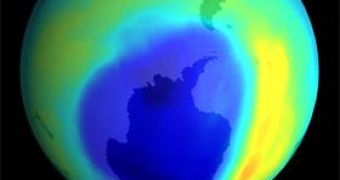Ozone is a colorless gas with a molecule of three atoms of oxygen that in the stratosphere (upper layer of the atmosphere 6 to 30 miles above the planet's surface) absorbs dangerous ultraviolet radiation from the sun.
In the absence of the protective ozone layer of the atmosphere, people's skin would suffer of all kind of cancers and the planet would be downright hostile to life as we know it.
Ultraviolet radiations have a powerful effect of provoking gene mutations on living organisms.
The holes on the ozone layer are not really areas without ozone but where ozone is very thin.
They occur over each pole during their respective hemisphere's spring.
It was already known these holes form when sunlight breaks up man-made chemicals, like chloroflurocarbons (or CFCs), and resulting gases such as chlorine destroy the ozone.
CFCs are non toxic and non flammable and were used for house holds like air conditioners, refrigerators, aerosol hair sprays and cleaning solvents.
In the 70's, scientists detected that high amounts of CFCs were escaping into the stratosphere.
These led to a global ban of these pollutants.
But other naturally-occurring chemicals can also eat away at the ozone, as a recent study has showed.
Scientists detected that in March 2006, stronger-than usual winds circling high above the Arctic pulled ozone-destroying nitrogen oxides down in altitude some 30 miles, where they could attack ozone in the upper stratosphere.
Nitrogen oxides are created above the stratosphere when sunlight breaks up nitrogen and oxygen molecules.
So, the winds have a greater impact on ozone levels than previously thought.
The damage caused by the winds on the North Pole area is only matched by the nearly 60 percent decrease in ozone in the winter of 2003-2004, when a series of powerful solar storms affected the area, creating higher amounts of nitrogen oxides.
"We knew strong winds would lead to more [nitrogen oxides] in the stratosphere if there were solar storms, but seeing that much come down into the stratosphere when the sun was essentially quiet was amazing," said lead author Cora Randall of the University of Colorado at Boulder.
The upper-level damage occurs far above the lower stratosphere's CFC-induced ozone hole, and so, it is not so threatening to life.
"But it could have unanticipated climate consequences because the upper-level ozone usually heats up the stratosphere as it absorbs ultraviolet radiation, "according to Randall.
"Human-induced climate change might also affect the strength of the polar winds, which could pull even more nitrogen oxides down into the stratosphere. The atmosphere is part of a coupled system, and what affects one layer of the atmosphere can influence other layers in surprising ways," Randall said.
"We will only be able to predict and understand the consequences of human activities if we study the entire system as a whole, not just in parts."
Scientists have been monitoring the ozone hole's annual maximum for signs of improvement since the Montreal Protocol, which phased out CFC's, was passed 19 years ago.
"The Antarctic ozone hole will reach sizes on the order of 8-10 million square miles nearly every year until about 2018 or so," said Paul Newman, a senior research scientist at NASA's Goddard Space Flight Center.
"That's larger than the entire continent of North America."
"Around 2018, things should slowly start improving, and somewhere between 2020 and 2025, we'll be able to detect that the ozone hole is actually beginning to decrease in size. Eventually the ozone hole will go back to its normal level around 2070 or so. So we will soon see what this year's peak will reveal about the ozone hole and our ability to predict its development and recovery."
"Though it is still too early to tell, the 2006 Antarctic ozone hole has not shown any substantial signs of recovery."

 14 DAY TRIAL //
14 DAY TRIAL //